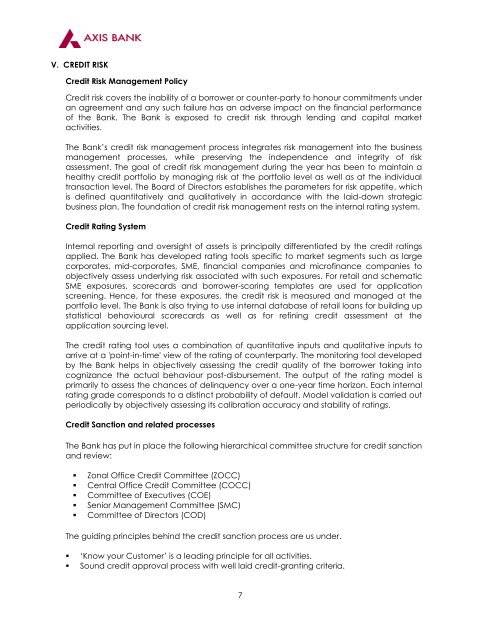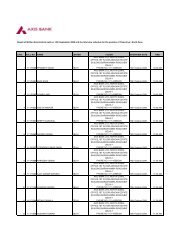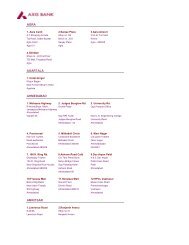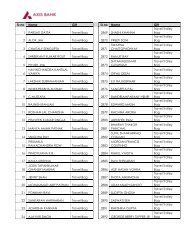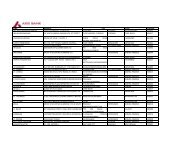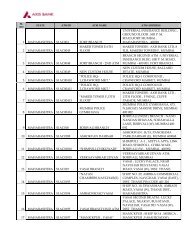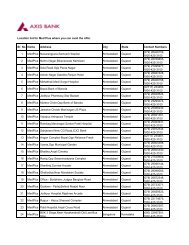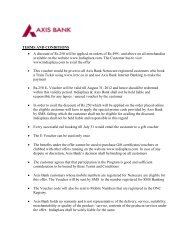Scope of Application
Scope of Application
Scope of Application
Create successful ePaper yourself
Turn your PDF publications into a flip-book with our unique Google optimized e-Paper software.
V. CREDIT RISK<br />
Credit Risk Management Policy<br />
Credit risk covers the inability <strong>of</strong> a borrower or counter-party to honour commitments under<br />
an agreement and any such failure has an adverse impact on the financial performance<br />
<strong>of</strong> the Bank. The Bank is exposed to credit risk through lending and capital market<br />
activities.<br />
The Bank‟s credit risk management process integrates risk management into the business<br />
management processes, while preserving the independence and integrity <strong>of</strong> risk<br />
assessment. The goal <strong>of</strong> credit risk management during the year has been to maintain a<br />
healthy credit portfolio by managing risk at the portfolio level as well as at the individual<br />
transaction level. The Board <strong>of</strong> Directors establishes the parameters for risk appetite, which<br />
is defined quantitatively and qualitatively in accordance with the laid-down strategic<br />
business plan. The foundation <strong>of</strong> credit risk management rests on the internal rating system.<br />
Credit Rating System<br />
Internal reporting and oversight <strong>of</strong> assets is principally differentiated by the credit ratings<br />
applied. The Bank has developed rating tools specific to market segments such as large<br />
corporates, mid-corporates, SME, financial companies and micr<strong>of</strong>inance companies to<br />
objectively assess underlying risk associated with such exposures. For retail and schematic<br />
SME exposures, scorecards and borrower-scoring templates are used for application<br />
screening. Hence, for these exposures, the credit risk is measured and managed at the<br />
portfolio level. The Bank is also trying to use internal database <strong>of</strong> retail loans for building up<br />
statistical behavioural scorecards as well as for refining credit assessment at the<br />
application sourcing level.<br />
The credit rating tool uses a combination <strong>of</strong> quantitative inputs and qualitative inputs to<br />
arrive at a 'point-in-time' view <strong>of</strong> the rating <strong>of</strong> counterparty. The monitoring tool developed<br />
by the Bank helps in objectively assessing the credit quality <strong>of</strong> the borrower taking into<br />
cognizance the actual behaviour post-disbursement. The output <strong>of</strong> the rating model is<br />
primarily to assess the chances <strong>of</strong> delinquency over a one-year time horizon. Each internal<br />
rating grade corresponds to a distinct probability <strong>of</strong> default. Model validation is carried out<br />
periodically by objectively assessing its calibration accuracy and stability <strong>of</strong> ratings.<br />
Credit Sanction and related processes<br />
The Bank has put in place the following hierarchical committee structure for credit sanction<br />
and review:<br />
� Zonal Office Credit Committee (ZOCC)<br />
� Central Office Credit Committee (COCC)<br />
� Committee <strong>of</strong> Executives (COE)<br />
� Senior Management Committee (SMC)<br />
� Committee <strong>of</strong> Directors (COD)<br />
The guiding principles behind the credit sanction process are us under.<br />
� „Know your Customer‟ is a leading principle for all activities.<br />
� Sound credit approval process with well laid credit-granting criteria.<br />
7


